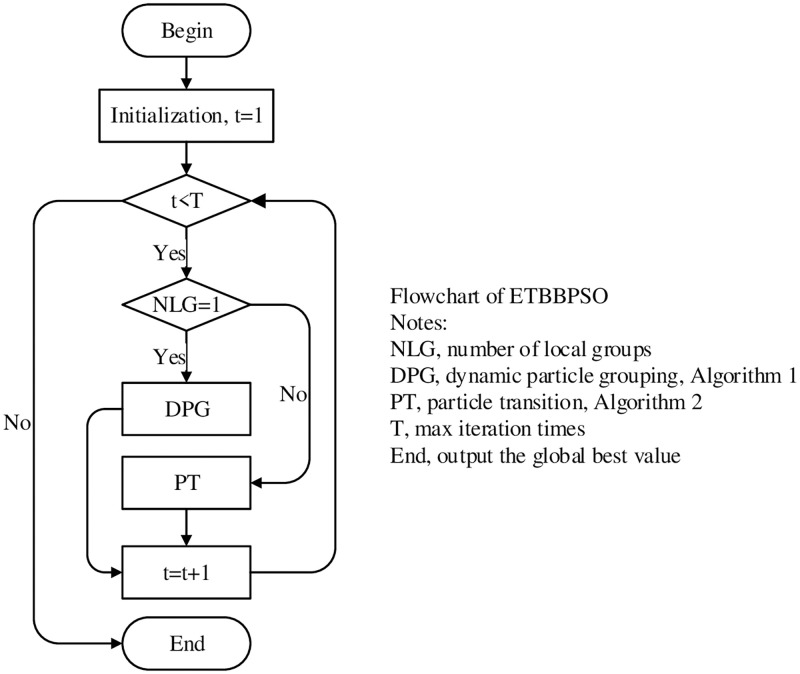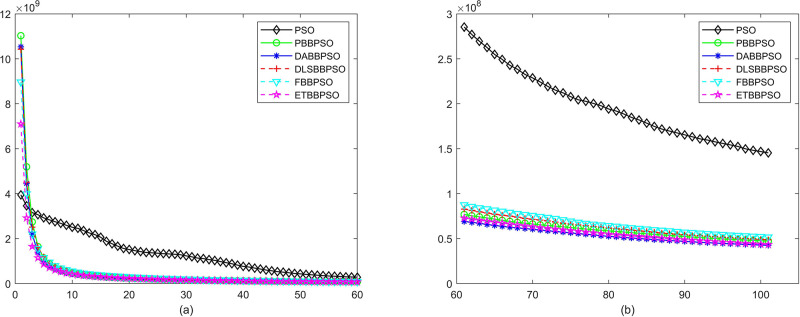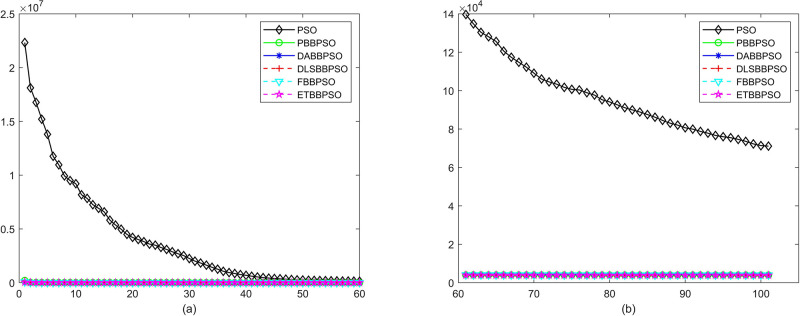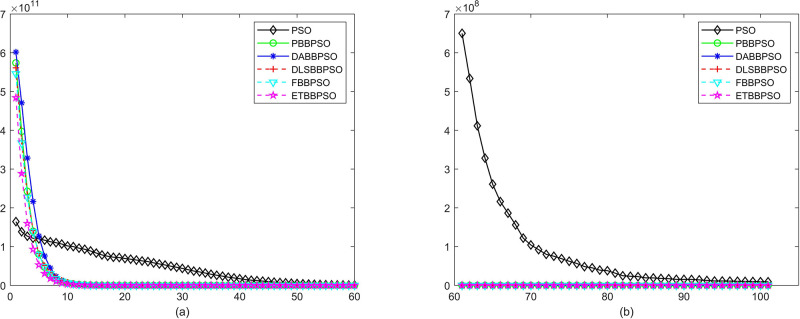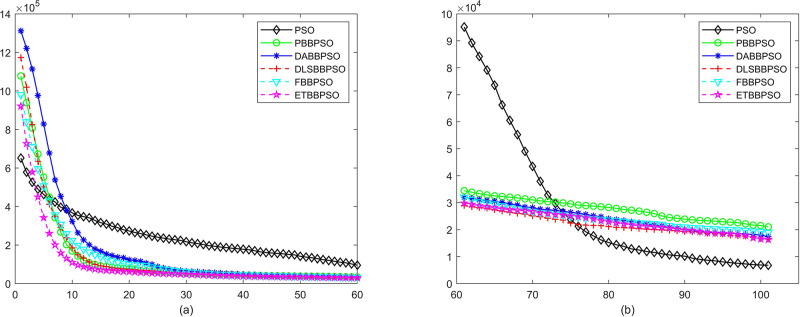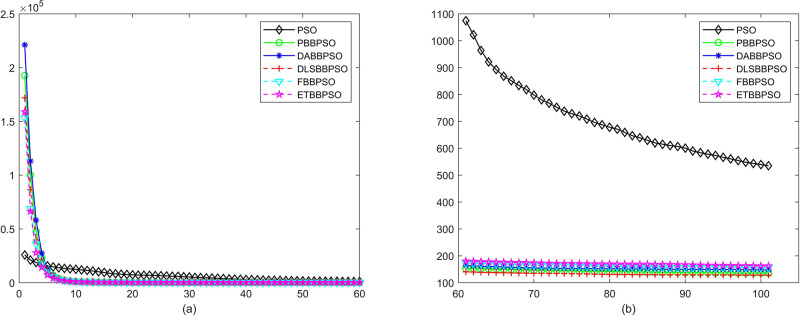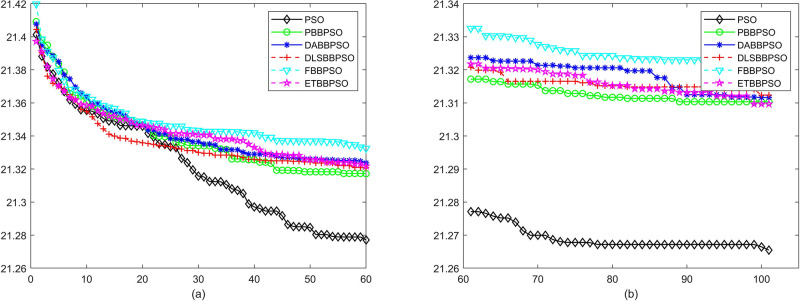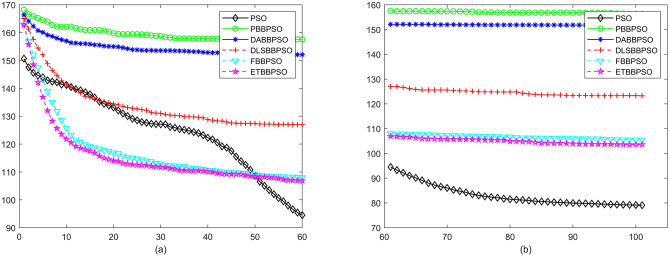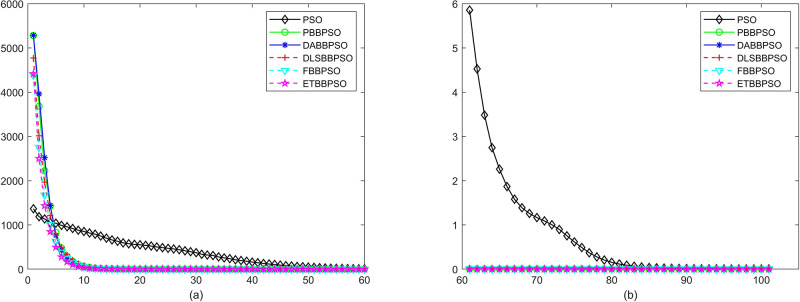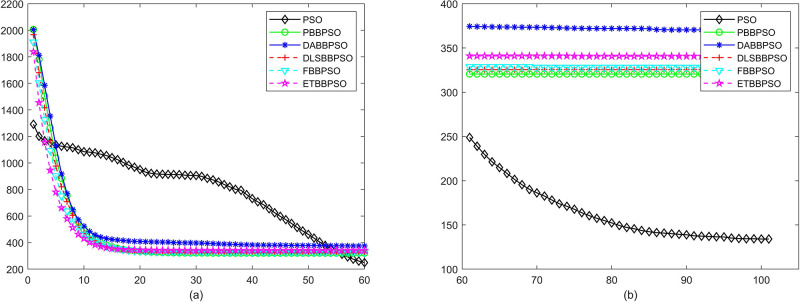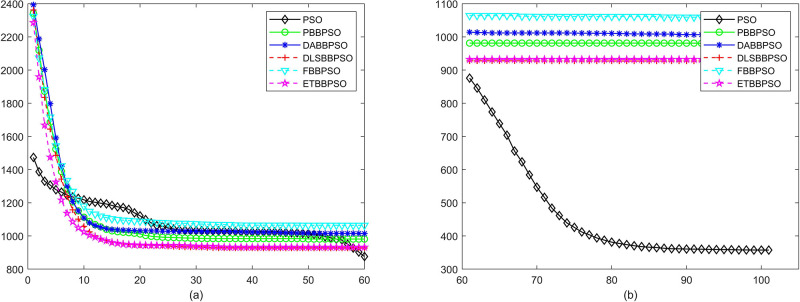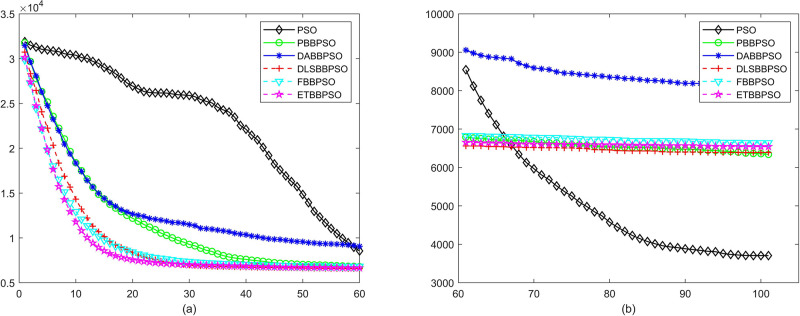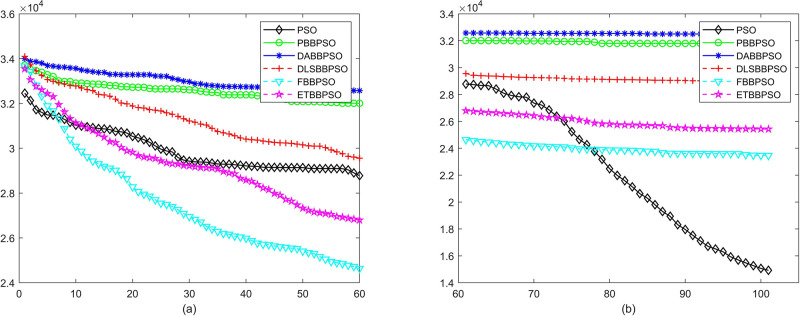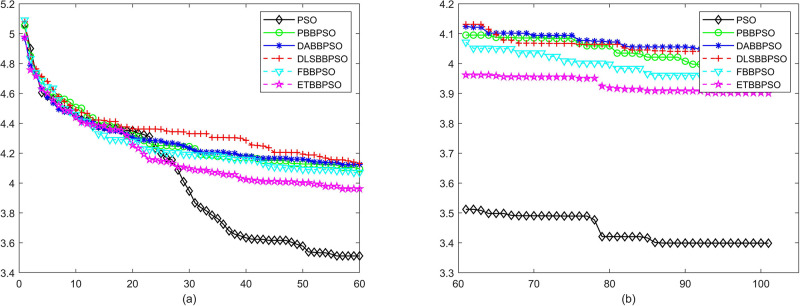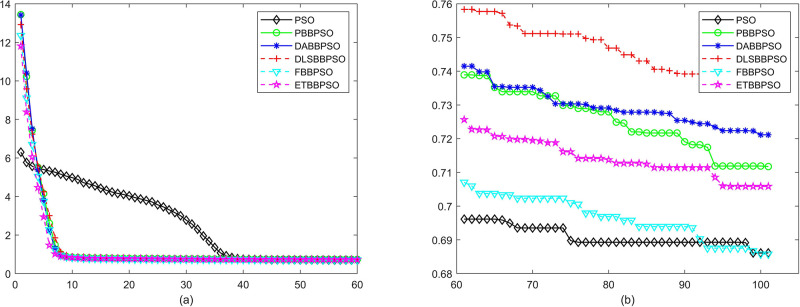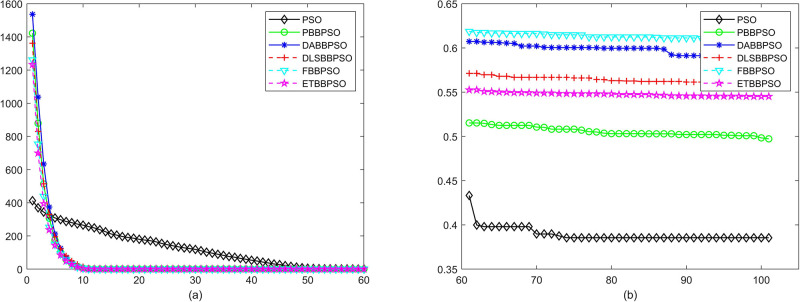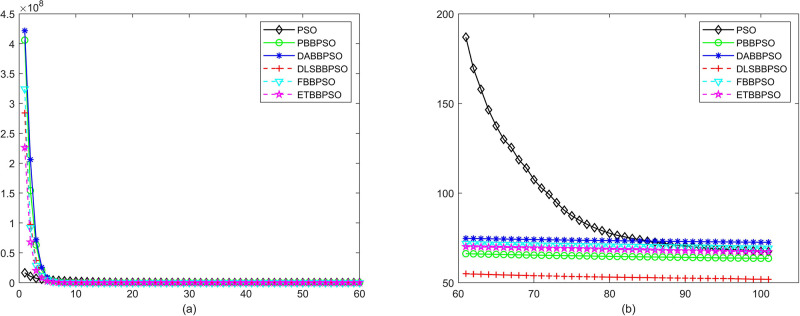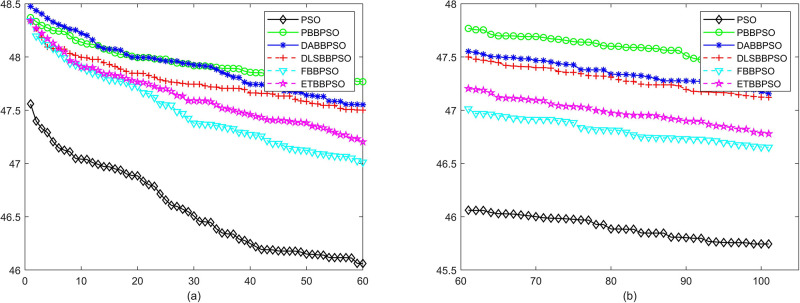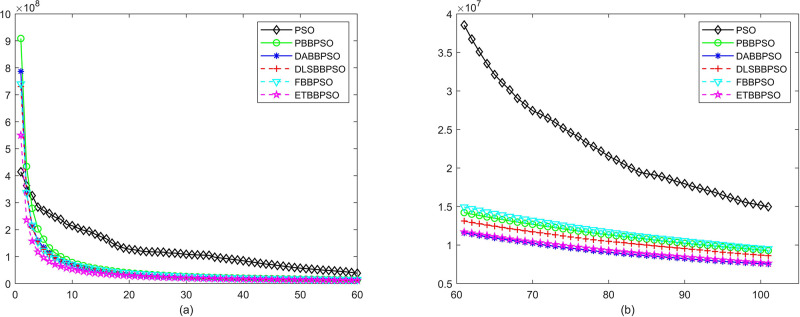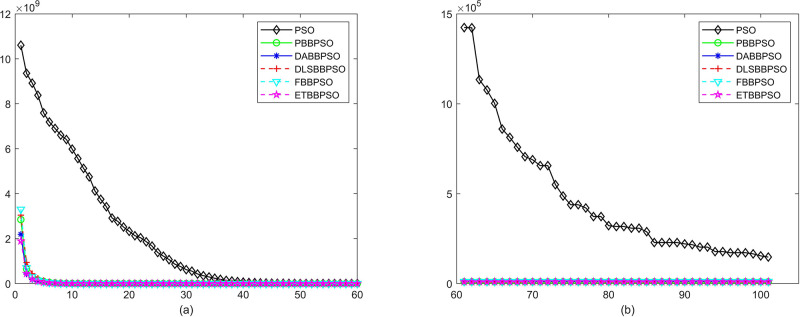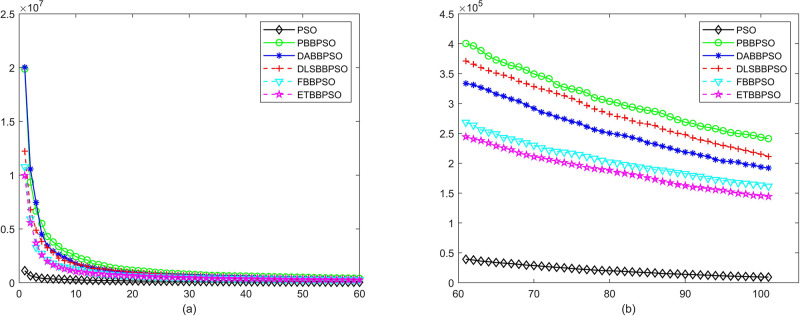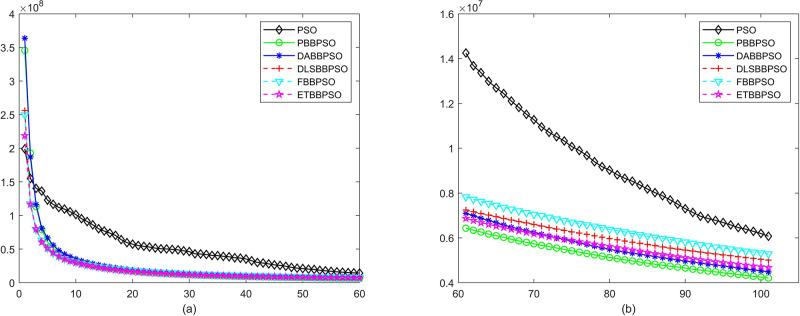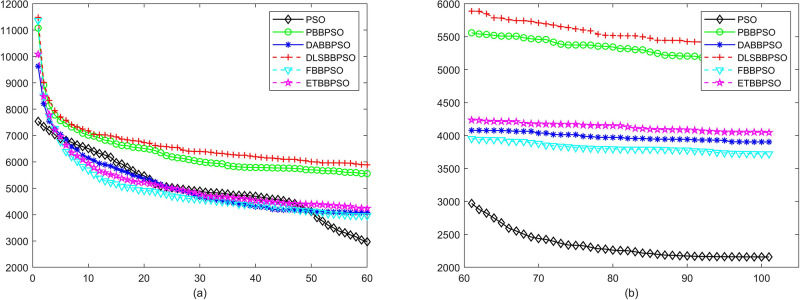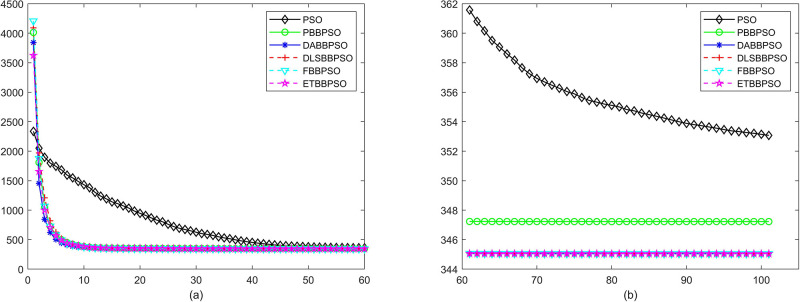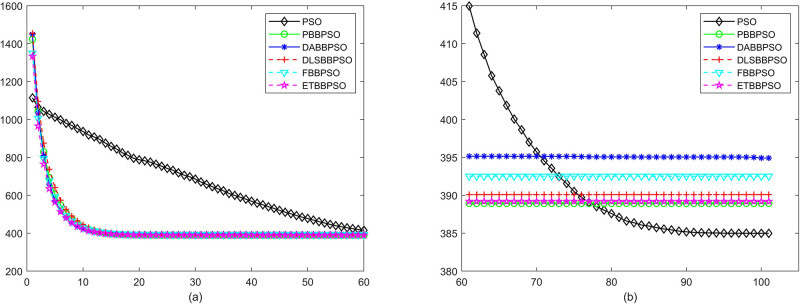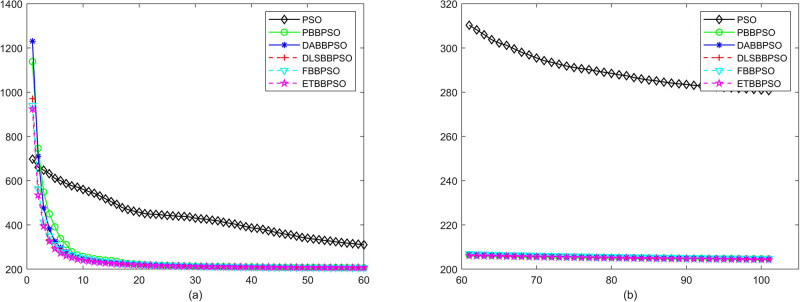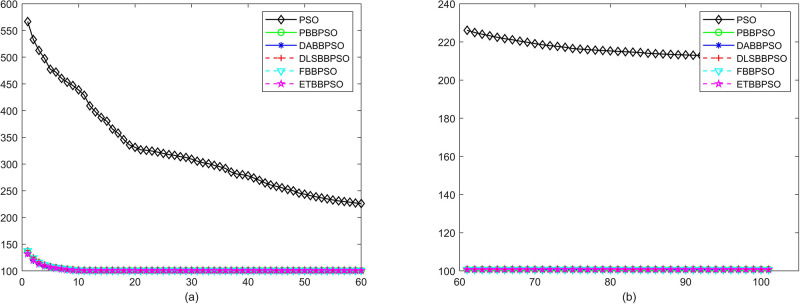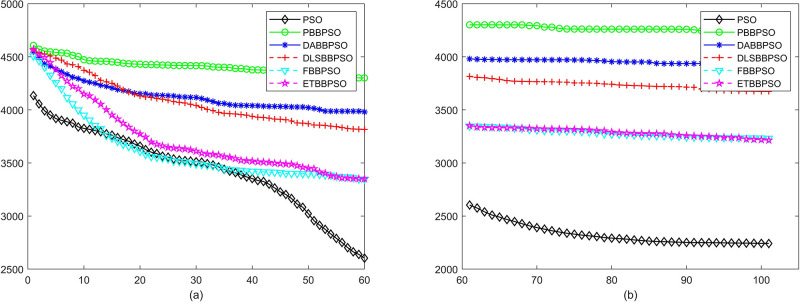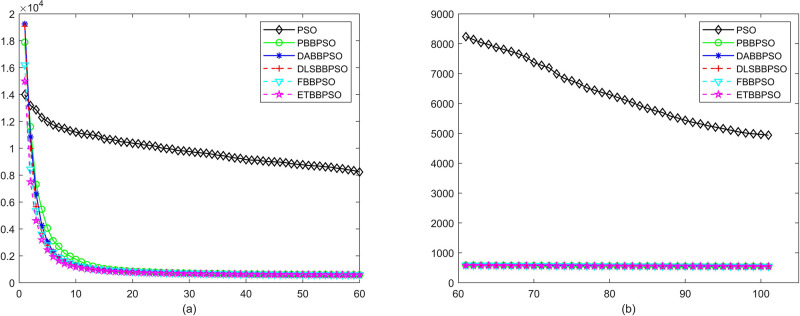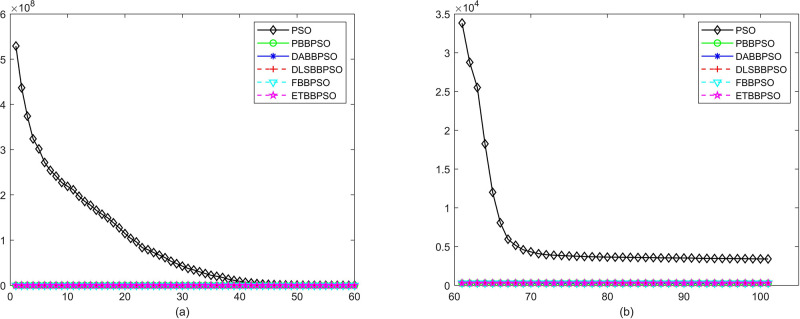Abstract
An electronic transition-based bare bones particle swarm optimization (ETBBPSO) algorithm is proposed in this paper. The ETBBPSO is designed to present high precision results for high dimensional single-objective optimization problems. Particles in the ETBBPSO are divided into different orbits. A transition operator is proposed to enhance the global search ability of ETBBPSO. The transition behavior of particles gives the swarm more chance to escape from local minimums. In addition, an orbit merge operator is proposed in this paper. An orbit with low search ability will be merged by an orbit with high search ability. Extensive experiments with CEC2014 and CEC2020 are evaluated with ETBBPSO. Four famous population-based algorithms are also selected in the control group. Experimental results prove that ETBBPSO can present high precision results for high dimensional single-objective optimization problems.
Introduction
An electron transition is essentially an energy change of electrons in the particles that make up matter. According to the principle of conservation of energy, the outer electrons of a particle absorb energy as they move from a lower to a higher energy level, and release energy as they move from a higher to a lower energy level. The energy is the absolute value of the difference between the energies of the two energy levels. In this paper, we use particles to simulated the electronic transition behavior to solve high dimensional optimization problems. Particles are designed to search in different orbits. The particles on the worse-positioned orbits have the opportunity to make a transition to the better-positioned orbits.
Optimization problems appear everywhere in our daily life. Whenever we want to make a choice, we believe the option is better. In numerical optimization problems, the numerous global optimization (GO) problems is often described in Eq 1:
| (1) |
where is a nonempty compact set that contains all feasible solutions, D is the dimension of the problem, f is a real valued objective function, x* is the theoretical optimal solution [1]. The purpose of an optimization algorithms is finding the x*, even the objective functions maybe non-convex, multimodal, or badly scaled [2].
To solve numerical optimization problems, population-based methods like genetic algorithms (GA) [3], differential evolution (DE) [4], particle swarm optimization (PSO) [5] ant colony (AC) [6], walf pack algorithm [7] are proposed. Among these methods, PSO is famous for fast convergence and easy applying. PSO algorithms are widely applied in engineering like route planning [8, 9], data clustering [10, 11], feature selection [12, 13], image segmentation [14, 15], power system [16, 17], engineering areas [18–20], and so on.
The class PSO algorithm is inspired by the social behavior of fish and birds. Particles begin searching from random solutions and aim at the solution which can minimize the target problem. In PSO, each particle represents a solution of the target problem. In function optimizations, each particle retains follow attributes: velocity, represents how fast a particle is moving in the search space; current fitness value, represents the function value at current position; current position, represents the coordinate at this generation; personal best value, represents the best function value across all generations; personal best position, represents the coordinate of the personal best value. The behavior of the particles is controlled by many parameters, so to achieve the best performance researchers need to adjust parameters for every specific problem. Also, with the developing of technology, optimization problems become high dimensional and multimodal. Traditional PSO methods sometimes difficult to provide high precision results. For some complicate prblems, PSO methods are easily fall into local minimal and leading to unacceptable results.
Researchers tried to improve the performance of PSO by combining different strategies. In 2016, Pornsing [21] propsoed a self-adaptive strategy to imoprove the search ability of PSO.In 2017, Chen proposed a new biogeography-based learning strategy for PSO [22]. In 2018, Xu proposed a novel chaotic PSO for combination optimization problems [23]. In 2018, Tian proposed a chaos-based initialization strategy and robust update mechanisms for PSO [24]. In 2019, Ghasemi proposed a new parameter control strategy to enhance the search ability of PSO [25]. In 2019, Xu [26] combined the quantum behavior with PSO and achieved better search ability. In 2021, Yamanaka tried to improve the performance PSO by introducing the new concept of particle clustering [27].
Bare bones PSO (BBPSO) [28] is a simple type of PSO. With the cancellation of the velocity term, BBPSO can solve different types of optimization problems without any parameters. In 2017, Guo [29] combined a pair-wise strategy with BBPSO (PBBPSO). Particles change information with a pair-particle during iterations. In addition, three particles are placed in one local group in hierarchical BBPSO (HBBPSO) [30]. Three particles form two different spatial structures to handle different optimization problems. On the other hand, Guo [31] proposed a dynamic local search strategy to enhance the local search ability of BBPSO. In 2018, Guo [32] developed a dynamic allocation operator for BBPSO. In 2019, Guo [33] proposed a fission-fusion strategy for BBPSO. In 2020, Guo [34] proposed a novel BBPSO based method for traveling salesman problem (TSP). Proposed method can present high precision for TSPs.
The rest of this paper is organized as follows: Section 2 introduces the proposed method; Section 3 introduces the numerical experiments; Section 4 presents the conclusions of this paper.
Materials and methods
The electronic transition-based bare bones particle swarm optimization (ETBBPSO) algorithm is proposed in this section.
Particle swarm explosion
The initialization of ETBBPSO is called particle swarm explosion (PSE). In PSE, particles are randomly dispersed into the search space. Then, the personal best position and the personal best value of every particle will be calculated. The global best position and the global best value of the particle swarm will be recorded.
Dynamic particle grouping
In ETBBPSO, particles will be assigned to different orbits. During the evolutionary process, particles in orbits play two different roles: the core and the satellite. Each orbits contains one core and several satellites. The number of satellites can be zero. Different evolutionary strategies are applied to different roles. A core particle aims at searching around the global best particles and Enhancing the global search capability of the orbit. The candidate position of a core particle is selected by Eq 2.
| (2) |
where the pbest(coret) is the personal best position of the core particle in (t)th generation, Gbestt is the personal best position of the global best particle in (t)th generation, pbest(coret+1)c andidate is the candidate new position for main particle in (t + 1)th generation, GauDis(α, β) is the Gaussian distribution with a mean α and a standard deviation β.
A satellite particle aims at searching around the core of the orbit and implementing a local search. The candidate position of a satellite particle is selected by Eq 3.
| (3) |
where the pbest(coret) is the personal best position of the core particle in (t)th generation, where the pbest(satellitet) is the personal best position of the satellite particle in (t)th generation, pbest(satellitet) is the personal best position of the global best particle in (t)th generation, pbest(satellitet+1)c andidate is the candidate new position for the satellite particle in (t + 1)th generation, GauDis(γ, δ) is the Gaussian distribution with a mean γ and a standard deviation δ.
A dynamic particle grouping (DPG) strategy is used to divide the particle swarm into different orbits. At the beginning of DPG, the particle x1 is selected as the core of the first Orbit. Then the next particle is selected to compare with the previous core. If the selected particle is better than the previous core, a new orbit will be created and the selected particle will be the core of the new orbit. Otherwise the particle will be a satellite of the original orbit. Then this process will be repeated until all particles have been assigned to orbits. The pseudo code of DPG is shown in Algorithm 1.
Algorithm 1 Dynamic Particle Grouping
Require: Max generation time, MIT
Require: Test function, F
Require: Search Space, R
Require: Number of particle, n
Require: Pbest_value
Require: Pbest_position
Require: Gbest_value
Require: Gbest_position
Require: No
Require: t
1: while t < MIT do
2: if NO == 1 then
3: t = t + 1
4: Select the first particle x1 as the core for Orbit(NO)
5: CurrentCore = xk
6: for i in range (2, n) do
7: if pbi < pbCurrentCore then
8: Select a new position for xi according to Eq 2
9: Create a new Orbit, NO = NO + 1
10: CurrentCore = xi
11: else
12: Make xi a satellite of CurrentCore, belonging to Orbit(NO)
13: Select a new position for xi according to Eq 3
14: end if
15: end for
16: Update Pbest_value, Pbest_position, Gbest_value,Gbest position
17: In each Orbit, make the particle with a smallest Pbest_value be the new core
18: end if
19: end while
Particle transition
To enhance the local search ability of the top orbit, the particle transition operator (PTO) is proposed. All orbits will be ranked according to the personal best value of their cores. Then all particles in the second best orbit will transit to the best orbit. By doing this the best orbit will gather more and more particles to obtain stronger local search ability. Other orbits still have change to do global search and replace the best orbit. The pseudo code of the PTO is shown in Algorithm 2.
Algorithm 2 Particle transition operator
Require: Max generation time, MIT
Require: Test function, F
Require: Search Space, R
Require: Number of particle, n
Require: Pbest_value
Require: Pbest_position
Require: Gbest_value
Require: Gbest_position
Require: NO, t
Require: Orbit
1: while t < MIT do
2: if NO > 1 then
3: t = t + 1
4: Rank all Orbits according the personal best values of their cores
5: A core with a smaller personal best value is a better core, its corresponding Orbit is the better Orbit
6: Merge the first and second best Orbits
7: Select a new position for all cores according to Eq 2
8: Select a new position for all satellites according to Eq 3
9: NO = NO − 1
10: Update Pbest_value,Pbest_position, Gbest_value,Gbest_position
11: end if
12: end while
Console
The DPG and the PTO collaborate to balance the local and global search. The DPG adaptive grouping strategy is applied so that the internal structure of the particle swarm can change with the change of the target problem. The PTO will merge the top two orbits. By doing this, the distribution of orbits enables the particle swarm to take into account the global search capability while enhancing the local search capability in specific regions. The overall process of ETBBPSO is shown in Algorithm 3. The flowchart of the ETBBPSO is shown in Fig 1.
Fig 1. The flowchart of ETBBPSO.
Algorithm 3 Console
Require: Max generation time, MIT
Require: Test function, F
Require: Search Space, R
Require: Number of particle, n
Require: Pbest_value, Pbest_position, Gbest_value, Gbest_position
Require: NO, t, Orbit
1: Run PSE
2: while t < MIT do
3: if NO == 1 then
4: Run Algorithm 1
5: end if
6: if NO > 1 then
7: Run Algorithm 2
8: end if
9: end while
Results
Experiments with CEC2014
In order to conduct a fair and comprehensive comparison, the CEC2014 benchmark functions are selected in experiments. Four famous population based methods PBBPSO [29], DABBPSO [32], DLS-BBPSO [31], and FBBPSO [33] are selected in the control group. PBBPSO conducts a novel paired evolution strategy and has shown reliable performance in single modal and multi-modal optimization problems. DABBPSO integrates the scattering and ordering of particle swarms. DLS-BBPSO carries out a dynamic local search operator and show powerful ability in single-objective optimization problems. FBBPSO is the state-of-the-art method based on Bare-bones PSO and has shown great performance and stability on CEC2014. To test the extreme optimization capability of ETBBPSO, experiments are conducted in 100-dimension, max generation time is 1.00E+4, population size for all algorithms is 100. Details of benchmark functions can be found in Table 1. All code are written in Matlab R2020b.
Table 1. Experimental functions, the CEC 2014 benchmark functions, the search range for each function is (-100,100), the dimension is 100.
| Types | Function Name | Dimension | Search Range | Theoretically Minimum |
|---|---|---|---|---|
| Unimodal Functions | f1 = Rotaten High Conditioned Elliptic Function | 100 | (-100,100) | 100 |
| f2 = Rotated Bent Cigar Function | 100 | (-100,100) | 200 | |
| f3 = Rotated Discus Function | 100 | (-100,100) | 300 | |
| Simple Multimodal Functions | f4 = Shifted and Rotated Rosenbrock’s Function | 100 | (-100,100) | 400 |
| f5 = Shifted and Rotated ACKLEY’s Function | 100 | (-100,100) | 500 | |
| f6 = Shifted and Rotated Weierstrass’s Function | 100 | (-100,100) | 600 | |
| f7 = Shifted and Rotated Griewank’s Function | 100 | (-100,100) | 700 | |
| f8 = Shifted Rastrigin’s Function | 100 | (-100,100) | 800 | |
| f9 = Shifted and Rotated Rastrigin’s Function | 100 | (-100,100) | 900 | |
| f10 = Shifted Schwefel’s Function | 100 | (-100,100) | 1000 | |
| f11 = Shifted and Rotated Schwefel’s Function | 100 | (-100,100) | 1100 | |
| f12 = Shifted and Rotated Katsure Function | 100 | (-100,100) | 1200 | |
| f13 = Shifted and Rotated HappyCat Function | 100 | (-100,100) | 1300 | |
| f14 = Shifted and Rotated HGBat Function | 100 | (-100,100) | 1400 | |
| f15 = Shifted and Rotated Expanded | 100 | (-100,100) | 1500 | |
| Griewank’s plus Rosenbrock’s Function | 100 | (-100,100) | ||
| f16 = Shifted and Rotated | 100 | (-100,100) | 1600 | |
| Expanded Scaffer’s F6 Function | 100 | (-100,100) | ||
| Hybrid Functions | f17 = Hybrid Function 1 (N = 3) | 100 | (-100,100) | 1700 |
| f18 = Hybrid Function 2 (N = 3) | 100 | (-100,100) | 1800 | |
| f19 = Hybrid Function 3 (N = 4) | 100 | (-100,100) | 1900 | |
| f20 = Hybrid Function 4 (N = 4) | 100 | (-100,100) | 2000 | |
| f21 = Hybrid Function 5 (N = 5) | 100 | (-100,100) | 2100 | |
| f22 = Hybrid Function 6 (N = 5) | 100 | (-100,100) | 2200 | |
| Composition Functions | f23 = Composition Function 1 (N = 5) | 100 | (-100,100) | 2300 |
| f24 = Composition Function 2 (N = 3) | 100 | (-100,100) | 2400 | |
| f25 = Composition Function 3 (N = 3) | 100 | (-100,100) | 2500 | |
| f26 = Composition Function 4 (N = 5) | 100 | (-100,100) | 2600 | |
| f27 = Composition Function 5 (N = 5) | 100 | (-100,100) | 2700 | |
| f28 = Composition Function 6 (N = 5) | 100 | (-100,100) | 2800 | |
| f29 = Composition Function 7 (N = 3) | 100 | (-100,100) | 2900 | |
| f30 = Composition Function 8 (N = 3) | 100 | (-100,100) | 3000 |
Experimental results and discussion
Experimental results are shown in Tables 2 and 3. Mean is the mean calculation error (CE) from 31 independent runs. CE is defined as |GlobalBestValue − TheoreticallyMinimum|. Std is the standard deviation of the 31 independent runs, Rank is the ranking results of the six algorithms. The Wilcoxon rank sum test is also implemented and average rank results are shown in Table 4.
Table 2. Experimental results, CE of PSO, PBBPSO, DA-BBPSO, DLS-BBPSO, FBBPSO and ETBBPSO for f1−f15.
Mean is the mean valut from 31 independent runs, STD is the standard deviation of the 31 runs, Rank is the rank of 6 algorithms.
| Function Number | Data Tpye | PSO | PBBPSO | DA-BBPSO | DLS-BBPSO | FBBPSO | ETBBPSO |
|---|---|---|---|---|---|---|---|
| f 1 | Mean | 1.454E+08 | 4.725E+07 | 4.253E+07 | 4.872E+07 | 5.172E+07 | 4.339E+07 |
| Std | 6.297E+07 | 1.608E+07 | 1.514E+07 | 1.505E+07 | 1.934E+07 | 1.797E+07 | |
| Rank | 6 | 3 | 1 | 4 | 5 | 2 | |
| f 2 | Mean | 9.363E+06 | 2.879E+04 | 5.013E+04 | 4.562E+04 | 3.781E+04 | 4.392E+04 |
| Std | 5.200E+07 | 4.923E+04 | 5.615E+04 | 4.438E+04 | 4.272E+04 | 5.973E+04 | |
| Rank | 6 | 1 | 5 | 4 | 2 | 3 | |
| f 3 | Mean | 6.772E+03 | 2.103E+04 | 1.736E+04 | 1.647E+04 | 1.893E+04 | 1.631E+04 |
| Std | 3.541E+03 | 1.666E+04 | 1.462E+04 | 1.391E+04 | 1.216E+04 | 1.052E+04 | |
| Rank | 1 | 6 | 4 | 3 | 5 | 2 | |
| f 4 | Mean | 5.351E+02 | 1.356E+02 | 1.470E+02 | 1.282E+02 | 1.551E+02 | 1.624E+02 |
| Std | 1.145E+02 | 4.452E+01 | 5.656E+01 | 4.246E+01 | 4.468E+01 | 4.725E+01 | |
| Rank | 6 | 2 | 3 | 1 | 4 | 5 | |
| f 5 | Mean | 2.127E+01 | 2.131E+01 | 2.131E+01 | 2.131E+01 | 2.132E+01 | 2.131E+01 |
| Std | 4.477E-02 | 3.207E-02 | 2.341E-02 | 2.662E-02 | 2.290E-02 | 2.535E-02 | |
| Rank | 1 | 3 | 4 | 5 | 6 | 2 | |
| f 6 | Mean | 7.908E+01 | 1.564E+02 | 1.517E+02 | 1.233E+02 | 1.055E+02 | 1.036E+02 |
| Std | 6.381E+00 | 1.074E+01 | 1.765E+01 | 3.031E+01 | 1.764E+01 | 1.928E+01 | |
| Rank | 1 | 6 | 5 | 4 | 3 | 2 | |
| f 7 | Mean | 4.081E-03 | 4.133E-03 | 1.987E-03 | 3.259E-03 | 4.606E-03 | 2.780E-03 |
| Std | 6.490E-03 | 5.486E-03 | 4.380E-03 | 5.736E-03 | 7.290E-03 | 5.494E-03 | |
| Rank | 4 | 5 | 1 | 3 | 6 | 2 | |
| f 8 | Mean | 1.340E+02 | 3.205E+02 | 3.704E+02 | 3.254E+02 | 3.281E+02 | 3.407E+02 |
| Std | 1.807E+01 | 6.020E+01 | 5.821E+01 | 4.384E+01 | 4.966E+01 | 4.927E+01 | |
| Rank | 1 | 2 | 6 | 3 | 4 | 5 | |
| f 9 | Mean | 3.573E+02 | 9.789E+02 | 1.006E+03 | 9.273E+02 | 1.059E+03 | 9.322E+02 |
| Std | 5.343E+01 | 1.442E+02 | 1.404E+02 | 1.586E+02 | 1.539E+02 | 1.740E+02 | |
| Rank | 1 | 4 | 5 | 2 | 6 | 3 | |
| f 10 | Mean | 3.705E+03 | 6.341E+03 | 8.020E+03 | 6.390E+03 | 6.642E+03 | 6.543E+03 |
| Std | 7.200E+02 | 8.816E+02 | 2.003E+03 | 8.226E+02 | 9.828E+02 | 8.886E+02 | |
| Rank | 1 | 2 | 6 | 3 | 5 | 4 | |
| f 11 | Mean | 1.492E+04 | 3.173E+04 | 3.249E+04 | 2.881E+04 | 2.346E+04 | 2.542E+04 |
| Std | 2.896E+03 | 3.209E+03 | 3.138E+03 | 7.556E+03 | 8.871E+03 | 7.969E+03 | |
| Rank | 1 | 5 | 6 | 4 | 2 | 3 | |
| f 12 | Mean | 3.399E+00 | 3.987E+00 | 4.040E+00 | 4.015E+00 | 3.960E+00 | 3.901E+00 |
| Std | 3.983E-01 | 2.166E-01 | 1.733E-01 | 2.399E-01 | 4.298E-01 | 6.487E-01 | |
| Rank | 1 | 4 | 6 | 5 | 3 | 2 | |
| f 13 | Mean | 6.861E-01 | 7.117E-01 | 7.211E-01 | 7.375E-01 | 6.858E-01 | 7.059E-01 |
| Std | 5.123E-02 | 8.652E-02 | 1.013E-01 | 9.950E-02 | 8.404E-02 | 8.266E-02 | |
| Rank | 2 | 4 | 5 | 6 | 1 | 3 | |
| f 14 | Mean | 3.855E-01 | 4.972E-01 | 5.907E-01 | 5.608E-01 | 6.102E-01 | 5.452E-01 |
| Std | 1.500E-01 | 2.573E-01 | 3.229E-01 | 2.760E-01 | 2.894E-01 | 2.632E-01 | |
| Rank | 1 | 2 | 5 | 4 | 6 | 3 | |
| f 15 | Mean | 6.745E+01 | 6.357E+01 | 7.252E+01 | 5.186E+01 | 6.924E+01 | 6.724E+01 |
| Std | 1.249E+01 | 1.804E+01 | 1.858E+01 | 1.901E+01 | 1.919E+01 | 2.413E+01 | |
| Rank | 4 | 2 | 6 | 1 | 5 | 3 |
Table 3. Experimental Results, CE of PSO, PBBPSO, DA-BBPSO, DLS-BBPSO, FBBPSO and ETBBPSO for f16−f30.
Mean is the mean valut from 31 independent runs, STD is the standard deviation of the 31 runs, Rank is the rank of 6 algorithms. Alvrage rank point is at the bottom of the table.
| Function Number | Data Tpye | PSO | PBBPSO | DA-BBPSO | DLS-BBPSO | FBBPSO | ETBBPSO |
|---|---|---|---|---|---|---|---|
| f 16 | Mean | 4.574E+01 | 4.741E+01 | 4.715E+01 | 4.712E+01 | 4.665E+01 | 4.678E+01 |
| Std | 4.751E-01 | 9.261E-01 | 9.833E-01 | 8.539E-01 | 9.872E-01 | 9.423E-01 | |
| Rank | 1 | 6 | 5 | 4 | 2 | 3 | |
| f 17 | Mean | 1.497E+07 | 9.276E+06 | 7.522E+06 | 8.617E+06 | 9.513E+06 | 7.641E+06 |
| Std | 6.872E+06 | 2.908E+06 | 3.370E+06 | 4.707E+06 | 6.360E+06 | 3.086E+06 | |
| Rank | 6 | 4 | 1 | 3 | 5 | 2 | |
| f 18 | Mean | 1.474E+05 | 9.621E+03 | 1.303E+04 | 7.654E+03 | 1.132E+04 | 1.008E+04 |
| Std | 8.087E+05 | 1.179E+04 | 2.912E+04 | 7.838E+03 | 1.296E+04 | 1.284E+04 | |
| Rank | 6 | 2 | 5 | 1 | 4 | 3 | |
| f 19 | Mean | 1.679E+02 | 1.088E+02 | 1.080E+02 | 1.135E+02 | 1.072E+02 | 1.065E+02 |
| Std | 1.780E+01 | 4.609E+01 | 3.587E+01 | 5.465E+01 | 4.175E+01 | 4.431E+01 | |
| Rank | 6 | 4 | 3 | 5 | 2 | 1 | |
| f 20 | Mean | 9.281E+03 | 2.410E+05 | 1.920E+05 | 2.112E+05 | 1.614E+05 | 1.443E+05 |
| Std | 2.844E+03 | 2.549E+05 | 1.207E+05 | 1.428E+05 | 1.337E+05 | 8.422E+04 | |
| Rank | 1 | 6 | 4 | 5 | 3 | 2 | |
| f 21 | Mean | 6.073E+06 | 4.210E+06 | 4.481E+06 | 5.010E+06 | 5.283E+06 | 4.672E+06 |
| Std | 3.942E+06 | 1.955E+06 | 2.218E+06 | 2.894E+06 | 2.809E+06 | 2.093E+06 | |
| Rank | 6 | 1 | 2 | 4 | 5 | 3 | |
| f 22 | Mean | 2.157E+03 | 5.133E+03 | 3.902E+03 | 5.345E+03 | 3.721E+03 | 4.044E+03 |
| Std | 5.585E+02 | 1.452E+03 | 1.231E+03 | 1.376E+03 | 6.787E+02 | 1.194E+03 | |
| Rank | 1 | 5 | 3 | 6 | 2 | 4 | |
| f 23 | Mean | 3.531E+02 | 3.472E+02 | 3.450E+02 | 3.450E+02 | 3.450E+02 | 3.450E+02 |
| Std | 1.536E+00 | 1.215E+01 | 1.036E-05 | 2.707E-05 | 4.445E-05 | 6.985E-06 | |
| Rank | 6 | 5 | 2 | 3 | 4 | 1 | |
| f 24 | Mean | 3.850E+02 | 3.889E+02 | 3.949E+02 | 3.901E+02 | 3.925E+02 | 3.892E+02 |
| Std | 4.407E+00 | 5.792E+00 | 7.376E+00 | 4.694E+00 | 6.482E+00 | 7.166E+00 | |
| Rank | 1 | 2 | 6 | 4 | 5 | 3 | |
| f 25 | Mean | 2.807E+02 | 2.046E+02 | 2.046E+02 | 2.045E+02 | 2.048E+02 | 2.043E+02 |
| Std | 1.254E+01 | 1.043E+00 | 8.726E-01 | 8.597E-01 | 1.138E+00 | 9.194E-01 | |
| Rank | 6 | 4 | 3 | 2 | 5 | 1 | |
| f 26 | Mean | 2.119E+02 | 1.007E+02 | 1.007E+02 | 1.007E+02 | 1.007E+02 | 1.007E+02 |
| Std | 5.258E+01 | 9.343E-02 | 8.228E-02 | 7.951E-02 | 7.457E-02 | 6.422E-02 | |
| Rank | 6 | 3 | 2 | 4 | 1 | 5 | |
| f 27 | Mean | 2.242E+03 | 4.229E+03 | 3.911E+03 | 3.674E+03 | 3.232E+03 | 3.214E+03 |
| Std | 1.554E+02 | 4.651E+02 | 6.673E+02 | 6.689E+02 | 4.774E+02 | 4.074E+02 | |
| Rank | 1 | 6 | 5 | 4 | 3 | 2 | |
| f 28 | Mean | 4.937E+03 | 5.430E+02 | 5.490E+02 | 5.587E+02 | 5.461E+02 | 5.448E+02 |
| Std | 1.227E+03 | 5.380E+01 | 7.079E+01 | 7.318E+01 | 3.959E+01 | 6.800E+01 | |
| Rank | 6 | 1 | 4 | 5 | 3 | 2 | |
| f 29 | Mean | 3.409E+03 | 2.664E+02 | 2.739E+02 | 2.777E+02 | 2.941E+02 | 2.947E+02 |
| Std | 7.679E+02 | 2.396E+01 | 3.576E+01 | 4.246E+01 | 5.769E+01 | 6.961E+01 | |
| Rank | 6 | 1 | 2 | 3 | 4 | 5 | |
| f 30 | Mean | 7.110E+04 | 3.965E+03 | 4.101E+03 | 3.600E+03 | 3.990E+03 | 3.895E+03 |
| Std | 3.459E+04 | 9.916E+02 | 9.365E+02 | 6.542E+02 | 1.013E+03 | 8.328E+02 | |
| Rank | 6 | 3 | 5 | 1 | 4 | 2 | |
| Average Rank | 3.40 | 3.47 | 4.00 | 3.53 | 3.83 | 2.77 |
Table 4. Parameters of the CEC2020 test.
| Dimension | 20 |
| Populatiuon size | 100 |
| Max iteration times | 10000 |
| Independent runs | 31 |
| Search Range | [-100,100] |
| Control Group | FBBPSO and BBPSO |
Numerical analyses are listed below: In f19, f23, f25, the result of ETBBPSO is ranked second among the six algorithms. In f1, f3, f5 − 7, f12, f17, f20, f27, f28, f30, the result of ETBBPSO is ranked second among the six algorithms. In f2, f9, f11, f13−16, f18, f21, f24, the result of ETBBPSO is ranked third among the six algorithms. It can be seen that ETBBPSO can present the top three results in 24 test functions. This proves that B is able to give an efficient optimization solution for most problems. It also proves that the electronic transition strategy can provide acceptable solutions for different problems. In f10 and f22, the result of ETBBPSO is ranked fourth among the six algorithms. In f4, f8, f26, f29, the result of ETBBPSO is ranked fifth among the six algorithms. These results suggest that ETBBPSO search ability is easily bounded in the face of such problems, and this is a major direction for future research. It is worth noting that ETBBPSO never finished last in the ranking test, which proves that ETBBPSO does not give extremely bad results even when faced with problems that it is not very good at handling. A ranking competition is designed for every test function. The algorithm presents the best results will get 1 point, presents the second-best results will get 2 points, presents the third-best results will get 3 points, presents the fourth-best results will get 4 points, presents the fifth-best results will get 5 points, presents the worst results will get 6 points. The mean ranking results are shown at the bottom of Table 2. ETBBPSO shows the best results in the 100-dimension test. This is mainly because DPG is able to divide the particle swarm into different orbits. The whole partitioning process is self-controlled by the algorithm and does not require any parameters. Then, PTO enhances the local search ability of particle swarm while taking into account the global search ability, making it more possible for the particle swarm to escape from the local optimum.
Evolutionary curves across iterations are shown in Figs 2 to 31. The horizontal axis represents the number of iterations, vertical axes represents CEs.
Fig 2. Comparison of convergence speed between PSO, PBBPSO, DA-BBPSO, DLS-BBPSO, FBBPSO and ETBBPSO, f1, (a) iteration 0-6000, (b) iteration 6000-10000 the unit is 100 iteration.
Fig 31. Comparison of convergence speed between PSO, PBBPSO, DA-BBPSO, DLS-BBPSO, FBBPSO and ETBBPSO, f30, (a) iteration 0-6000, (b) iteration 6000-10000 the unit is 100 iteration.
Fig 3. Comparison of convergence speed between PSO, PBBPSO, DA-BBPSO, DLS-BBPSO, FBBPSO and ETBBPSO, f2, (a) iteration 0-6000, (b) iteration 6000-10000 the unit is 100 iteration.
Fig 4. Comparison of convergence speed between PSO, PBBPSO, DA-BBPSO, DLS-BBPSO, FBBPSO and ETBBPSO, f3, (a) iteration 0-6000, (b) iteration 6000-10000 the unit is 100 iteration.
Fig 5. Comparison of convergence speed between PSO, PBBPSO, DA-BBPSO, DLS-BBPSO, FBBPSO and ETBBPSO, f4, (a) iteration 0-6000, (b) iteration 6000-10000 the unit is 100 iteration.
Fig 6. Comparison of convergence speed between PSO, PBBPSO, DA-BBPSO, DLS-BBPSO, FBBPSO and ETBBPSO, f5, (a) iteration 0-6000, (b) iteration 6000-10000 the unit is 100 iteration.
Fig 7. Comparison of convergence speed between PSO, PBBPSO, DA-BBPSO, DLS-BBPSO, FBBPSO and ETBBPSO, f6, (a) iteration 0-6000, (b) iteration 6000-10000 the unit is 100 iteration.
Fig 8. Comparison of convergence speed between PSO, PBBPSO, DA-BBPSO, DLS-BBPSO, FBBPSO and ETBBPSO, f7, (a) iteration 0-6000, (b) iteration 6000-10000 the unit is 100 iteration.
Fig 9. Comparison of convergence speed between PSO, PBBPSO, DA-BBPSO, DLS-BBPSO, FBBPSO and ETBBPSO, f8, (a) iteration 0-6000, (b) iteration 6000-10000 the unit is 100 iteration.
Fig 10. Comparison of convergence speed between PSO, PBBPSO, DA-BBPSO, DLS-BBPSO, FBBPSO and ETBBPSO, f9, (a) iteration 0-6000, (b) iteration 6000-10000 the unit is 100 iteration.
Fig 11. Comparison of convergence speed between PSO, PBBPSO, DA-BBPSO, DLS-BBPSO, FBBPSO and ETBBPSO, f10, (a) iteration 0-6000, (b) iteration 6000-10000 the unit is 100 iteration.
Fig 12. Comparison of convergence speed between PSO, PBBPSO, DA-BBPSO, DLS-BBPSO, FBBPSO and ETBBPSO, f11, (a) iteration 0-6000, (b) iteration 6000-10000 the unit is 100 iteration.
Fig 13. Comparison of convergence speed between PSO, PBBPSO, DA-BBPSO, DLS-BBPSO, FBBPSO and ETBBPSO, f12, (a) iteration 0-6000, (b) iteration 6000-10000 the unit is 100 iteration.
Fig 14. Comparison of convergence speed between PSO, PBBPSO, DA-BBPSO, DLS-BBPSO, FBBPSO and ETBBPSO, f13, (a) iteration 0-6000, (b) iteration 6000-10000, the unit is 100 iteration.
Fig 15. Comparison of convergence speed between PSO, PBBPSO, DA-BBPSO, DLS-BBPSO, FBBPSO and ETBBPSO, f14, (a) iteration 0-6000, (b) iteration 6000-10000 the unit is 100 iteration.
Fig 16. Comparison of convergence speed between PSO, PBBPSO, DA-BBPSO, DLS-BBPSO, FBBPSO and ETBBPSO, f15, (a) iteration 0-6000, (b) iteration 6000-10000 the unit is 100 iteration.
Fig 17. Comparison of convergence speed between PSO, PBBPSO, DA-BBPSO, DLS-BBPSO, FBBPSO and ETBBPSO, f16, (a) iteration 0-6000, (b) iteration 6000-10000 the unit is 100 iteration.
Fig 18. Comparison of convergence speed between PSO, PBBPSO, DA-BBPSO, DLS-BBPSO, FBBPSO and ETBBPSO, f17, (a) iteration 0-6000, (b) iteration 6000-10000 the unit is 100 iteration.
Fig 19. Comparison of convergence speed between PSO, PBBPSO, DA-BBPSO, DLS-BBPSO, FBBPSO and ETBBPSO,f18, (a) iteration 0-6000, (b) iteration 6000-10000 the unit is 100 iteration.
Fig 20. Comparison of convergence speed between PSO, PBBPSO, DA-BBPSO, DLS-BBPSO, FBBPSO and ETBBPSO, f19, (a) iteration 0-6000, (b) iteration 6000-10000 the unit is 100 iteration.
Fig 21. Comparison of convergence speed between PSO, PBBPSO, DA-BBPSO, DLS-BBPSO, FBBPSO and ETBBPSO, f20, (a) iteration 0-6000, (b) iteration 6000-10000 the unit is 100 iteration.
Fig 22. Comparison of convergence speed between PSO, PBBPSO, DA-BBPSO, DLS-BBPSO, FBBPSO and ETBBPSO, f21, (a) iteration 0-6000, (b) iteration 6000-10000 the unit is 100 iteration.
Fig 23. Comparison of convergence speed between PSO, PBBPSO, DA-BBPSO, DLS-BBPSO, FBBPSO and ETBBPSO, f22, (a) iteration 0-6000, (b) iteration 6000-10000 the unit is 100 iteration.
Fig 24. Comparison of convergence speed between PSO, PBBPSO, DA-BBPSO, DLS-BBPSO, FBBPSO and ETBBPSO, f23, (a) iteration 0-6000, (b) iteration 6000-10000 the unit is 100 iteration.
Fig 25. Comparison of convergence speed between PSO, PBBPSO, DA-BBPSO, DLS-BBPSO, FBBPSO and ETBBPSO, f24, (a) iteration 0-6000, (b) iteration 6000-10000 the unit is 100 iteration.
Fig 26. Comparison of convergence speed between PSO, PBBPSO, DA-BBPSO, DLS-BBPSO, FBBPSO and ETBBPSO, f25, (a) iteration 0-6000, (b) iteration 6000-10000 the unit is 100 iteration.
Fig 27. Comparison of convergence speed between PSO, PBBPSO, DA-BBPSO, DLS-BBPSO, FBBPSO and ETBBPSO, f26, (a) iteration 0-6000, (b) iteration 6000-10000 the unit is 100 iteration.
Fig 28. Comparison of convergence speed between PSO, PBBPSO, DA-BBPSO, DLS-BBPSO, FBBPSO and ETBBPSO, f27, (a) iteration 0-6000, (b) iteration 6000-10000 the unit is 100 iteration.
Fig 29. Comparison of convergence speed between PSO, PBBPSO, DA-BBPSO, DLS-BBPSO, FBBPSO and ETBBPSO, f28, (a) iteration 0-6000, (b) iteration 6000-10000 the unit is 100 iteration.
Fig 30. Comparison of convergence speed between PSO, PBBPSO, DA-BBPSO, DLS-BBPSO, FBBPSO and ETBBPSO, f29, (a) iteration 0-6000, (b) iteration 6000-10000 the unit is 100 iteration.
Discussion
A ranking competition is designed for every test function. The algorithm presents the best results will get 1 point, presents the second-best results will get 2 point, presents the third-best results will get 3 point, presents the forth-best results will get 4 point, presents the fifth-best results will get 5 point, presents the worst results will get 6 point. The mean ranking results are show in the bottom of Table 3. ETBBPSO shows the best results in the 100-dimension test. This is mainly because DPG is able to divide the particle swarm into different orbits. The whole partitioning process is self-controlled by the algorithm and does not require any parameters. Then, PTO enhances the local search ability of particle swarm while taking into account the global search ability, making it more possible for the particle swarm to escape from the local optimum.
Experiments with CEC2020
The standard BBPSO and the ETBBPSO are tested with the CEC2020 benchmark functions. Parameters are shown in Table 4. Experimental results are shown in Table 5. CE is defined as |GlobalBestValue−TheoreticallyMinimum|. The ETBBPSO scored 4 firsts and 4 seconds in 10 test functions, shown great performance in this experiments.
Table 5. Experimental Results with CEC2020, CEs of BBPSO and ETBBPSO.
Mean is the mean valut from 31 independent runs, STD is the standard deviation of the 31 runs.
| Function Number | Data Tpye | FBBPSO | BBPSO | ETBBPSO |
|---|---|---|---|---|
| f 1 | Mean | 3.002E+04 | 1.278E+04 | 1.778E+04 |
| Std | 3.915E+04 | 2.346E+04 | 3.322E+04 | |
| Rank | 3 | 1 | 2 | |
| f 2 | Mean | 5.768E+02 | 6.037E+02 | 5.568E+02 |
| Std | 2.124E+02 | 2.718E+02 | 2.086E+02 | |
| Rank | 2 | 3 | 1 | |
| f 3 | Mean | 4.746E+01 | 4.553E+01 | 4.348E+01 |
| Std | 9.161E+00 | 1.028E+01 | 1.141E+01 | |
| Rank | 3 | 2 | 1 | |
| f 4 | Mean | 2.238E+00 | 2.506E+00 | 2.473E+00 |
| Std | 1.021E-00 | 9.659E-01 | 8.925E-01 | |
| Rank | 1 | 3 | 2 | |
| f 5 | Mean | 9.121E+04 | 8.048E+04 | 7.323E+04 |
| Std | 8.335E+04 | 7.829E+04 | 7.657E+04 | |
| Rank | 3 | 2 | 1 | |
| f 6 | Mean | 1.176E+01 | 2.218E+01 | 2.948E+01 |
| Std | 1.335E+01 | 3.763E+01 | 4.494E+01 | |
| Rank | 1 | 2 | 3 | |
| f 7 | Mean | 4.601E+04 | 3.929E+04 | 4.205E+04 |
| Std | 3.750E+04 | 2.595E+04 | 4.416E+04 | |
| Rank | 3 | 1 | 2 | |
| f 8 | Mean | 1.429E+03 | 1.219E+03 | 8.123E+02 |
| Std | 1.217E+03 | 1.085E+03 | 1.013E+03 | |
| Rank | 3 | 2 | 1 | |
| f 9 | Mean | 4.614E+02 | 4.725E+02 | 4.623E+02 |
| Std | 2.869E+01 | 2.237E+01 | 2.611E+01 | |
| Rank | 1 | 3 | 2 | |
| f 10 | Mean | 4.363E+02 | 4.317E+02 | 4.387E+02 |
| Std | 3.185E+01 | 3.263E+01 | 3.014E+01 | |
| Rank | 2 | 1 | 3 | |
| Average Rank | 2.2 | 2 | 1.8 |
Conclusions
In this paper, a novel electronic transition-based bare bones particle swarm optimization (ETBBPSO) algorithm is proposed for high dimensional optimization problems. A dynamic particle grouping (DPG) strategy and a particle transition operator (PTO) collaborate to find the global optimal solution for high dimensional optimization problems. The DPG is mainly used to assign particles to different orbits, with a variable number of orbits and a variable number of particles per orbit. The PTO is used to combine the best and the second-best orbits. Particles that belong to the second-best orbits will transit to the best orbit to enhance the local search ability of the best orbit. A set of comprehensive experiments are designed to verify the optimization ability of ETBBPSO. Several famous population-based methods are used in the control group. Experimental results prove that ETBBPSO is able to present high precision results for high dimensional optimization problems.
Data Availability
All relevant data are within the paper.
Funding Statement
Hao Tian is supported by the Hubei University of Economics Research and Cultivation Key Projects PYZD202001; Yuji Sato is supported by the JSPS KAKENHI Grant Numbers JP19K12162; The funders had no role in study design, data collection and analysis, decision to publish, or preparation of the manuscript.
References
- 1. Parsopoulos KE, Vrahatis MN. Recent approaches to global optimization problems through Particle Swarm Optimization. Natural Computing. 2002;1(2/3):235–306. doi: 10.1023/A:1016568309421 [DOI] [Google Scholar]
- 2. Hu J, Wang Y, Zhou E, Fu MC, Marcus SI. A Survey of Some Model-Based Methods for Global Optimization. In: Optimization, Control, and Applications of Stochastic Systems. Boston: Birkhäuser Boston; 2012. p. 157–179. [Google Scholar]
- 3. Srinivas M, Patnaik LM. Genetic Algorithms: A Survey. Computer. 1994;27(6). doi: 10.1109/2.294849 [DOI] [Google Scholar]
- 4. Das S, Suganthan PN. Differential evolution: A survey of the state-of-the-art. IEEE Transactions on Evolutionary Computation. 2011;15(1). doi: 10.1109/TEVC.2010.2059031 [DOI] [Google Scholar]
- 5.Kennedy J, Eberhart R. Particle swarm optimization. Neural Networks, 1995 Proceedings, IEEE International Conference on. 4:1942–1948 vol.4. 10.1109/ICNN.1995.488968 [DOI]
- 6. Dorigo M, Blum C. Ant colony optimization theory: A survey. Theoretical Computer Science. 2005. doi: 10.1016/j.tcs.2005.05.020 [DOI] [Google Scholar]
- 7. Chen X, Cheng F, Liu C, Cheng L, Mao Y. An improved Wolf pack algorithm for optimization problems: Design and evaluation. PLoS ONE. 2021;16(8 August 2021):1–23. doi: 10.1371/journal.pone.0254239 [DOI] [PMC free article] [PubMed] [Google Scholar]
- 8. Liang S, Jiao T, Du W, Qu S. An improved ant colony optimization algorithm based on context for tourism route planning. PLoS ONE. 2021;16(9 September):1–16. doi: 10.1371/journal.pone.0257317 [DOI] [PMC free article] [PubMed] [Google Scholar]
- 9. Fu Y, Ding M, Zhou C. Phase angle-encoded and quantum-behaved particle swarm optimization applied to three-dimensional route planning for UAV. IEEE Transactions on Systems, Man, and Cybernetics Part A:Systems and Humans. 2012;42(2):511–526. doi: 10.1109/TSMCA.2011.2159586 [DOI] [Google Scholar]
- 10. Jiang B, Wang N. Cooperative bare-bone particle swarm optimization for data clustering. Soft Computing. 2014;18(6):1079–1091. doi: 10.1007/s00500-013-1128-1 [DOI] [Google Scholar]
- 11. Lai DTC, Miyakawa M, Sato Y. Semi-supervised data clustering using particle swarm optimisation. Soft Computing. 2020;24(5):3499–3510. doi: 10.1007/s00500-019-04114-z [DOI] [Google Scholar]
- 12. Teng X, Dong H, Zhou X. Adaptive feature selection using v-shaped binary particle swarm optimization. PLoS ONE. 2017;12(3):1–22. doi: 10.1371/journal.pone.0173907 [DOI] [PMC free article] [PubMed] [Google Scholar]
- 13. Xue B, Zhang M, Browne WN. Particle swarm optimization for feature selection in classification: A multi-objective approach. IEEE Transactions on Cybernetics. 2013;43(6):1656–1671. doi: 10.1109/TSMCB.2012.2227469 [DOI] [PubMed] [Google Scholar]
- 14. Tan TY, Zhang L, Lim CP, Fielding B, Yu Y, Anderson E. Evolving Ensemble Models for Image Segmentation Using Enhanced Particle Swarm Optimization. IEEE Access. 2019;7:34004–34019. doi: 10.1109/ACCESS.2019.2903015 [DOI] [Google Scholar]
- 15. Yang Z, Wu A. A non-revisiting quantum-behaved particle swarm optimization based multilevel thresholding for image segmentation. Neural Computing and Applications. 2020;32(16):12011–12031. doi: 10.1007/s00521-019-04210-z [DOI] [Google Scholar]
- 16. Zhang X, Zou D, Shen X. A novel simple particle swarm optimization algorithm for global optimization. Mathematics. 2018;6(12). doi: 10.3390/math6120287 [DOI] [Google Scholar]
- 17. Wang Z, Fu Y, Song C, Zeng P, Qiao L. Power System Anomaly Detection Based on OCSVM Optimized by Improved Particle Swarm Optimization. IEEE Access. 2019;7:181580–181588. doi: 10.1109/ACCESS.2019.2959699 [DOI] [Google Scholar]
- 18. Ray R, Kumar D, Samui P, Roy LB, Goh ATC, Zhang W. Application of soft computing techniques for shallow foundation reliability in geotechnical engineering. Geoscience Frontiers. 2021;12(1). doi: 10.1016/j.gsf.2020.05.003 [DOI] [Google Scholar]
- 19. Ben Seghier MEA, Corriea JAFO, Jafari-Asl J, Malekjafarian A, Plevris V, Trung NT. On the modeling of the annual corrosion rate in main cables of suspension bridges using combined soft computing model and a novel nature-inspired algorithm. Neural Computing and Applications. 2021;33(23). 10.1007/s00521-021-06199-w [DOI] [Google Scholar]
- 20. Jafari-Asl J, Sami Kashkooli B, Bahrami M. Using particle swarm optimization algorithm to optimally locating and controlling of pressure reducing valves for leakage minimization in water distribution systems. Sustainable Water Resources Management. 2020;6(4). doi: 10.1007/s40899-020-00426-3 [DOI] [Google Scholar]
- 21. Pornsing C, Sodhi MS, Lamond BF. Novel self-adaptive particle swarm optimization methods. Soft Computing. 2016;20(9). doi: 10.1007/s00500-015-1716-3 [DOI] [Google Scholar]
- 22. Chen X, Tianfield H, Mei C, Du W, Liu G. Biogeography-based learning particle swarm optimization. Soft Computing. 2017;21(24). doi: 10.1007/s00500-016-2307-7 [DOI] [Google Scholar]
- 23. Xu X, Rong H, Trovati M, Liptrott M, Bessis N. CS-PSO: chaotic particle swarm optimization algorithm for solving combinatorial optimization problems. Soft Computing. 2018;22(3):783–795. doi: 10.1007/s00500-016-2383-8 [DOI] [Google Scholar]
- 24. Tian D, Shi Z. MPSO: Modified particle swarm optimization and its applications. Swarm and Evolutionary Computation. 2018;41:49–68. doi: 10.1016/j.swevo.2018.01.011 [DOI] [Google Scholar]
- 25. Ghasemi M, Akbari E, Rahimnejad A, Razavi SE, Ghavidel S, Li L. Phasor particle swarm optimization: a simple and efficient variant of PSO. Soft Computing. 2019;23(19). doi: 10.1007/s00500-018-3536-8 [DOI] [Google Scholar]
- 26. Xu L, Muhammad A, Pu Y, Zhou J, Zhang Y. Fractional-order quantum particle swarm optimization. PLoS ONE. 2019;14(6):1–16. doi: 10.1371/journal.pone.0218285 [DOI] [PMC free article] [PubMed] [Google Scholar]
- 27. Yamanaka Y, Yoshida K. Simple gravitational particle swarm algorithm for multimodal optimization problems. PLoS ONE. 2021;16(3 March):1–23. doi: 10.1371/journal.pone.0248470 [DOI] [PMC free article] [PubMed] [Google Scholar]
- 28. Kennedy J. Bare bones particle swarms. In: Proceedings of the 2003 IEEE Swarm Intelligence Symposium. SIS’03; 2003. p. 80–87. [Google Scholar]
- 29. Guo J, Sato Y. A Pair-wise Bare Bones Particle Swarm Optimization Algorithm for Nonlinear Functions. International Journal of Networked and Distributed Computing. 2017;5(3):143. doi: 10.2991/ijndc.2017.5.3.3 [DOI] [Google Scholar]
- 30.Guo J, Sato Y. A Hierarchical Bare Bones Particle Swarm Optimization Algorithm. In: 2017 IEEE International Conference on Systems, Man, and Cybernetics (SMC). IEEE; 2017. p. 1936–1941.
- 31. Guo J, Sato Y. A Bare Bones Particle Swarm Optimization Algorithm with Dynamic Local Search. In: Studies in Computational Intelligence. vol. 248; 2017. p. 158–165. [Google Scholar]
- 32. Guo J, Sato Y. A dynamic allocation bare bones particle swarm optimization algorithm and its application. Artificial Life and Robotics. 2018;23(3):353–358. doi: 10.1007/s10015-018-0440-3 [DOI] [Google Scholar]
- 33. Guo J, Sato Y. A fission-fusion hybrid bare bones particle swarm optimization algorithm for single-objective optimization problems. Applied Intelligence. 2019;49(10):3641–3651. doi: 10.1007/s10489-019-01474-9 [DOI] [Google Scholar]
- 34. Guo J, Sato Y. A Standardized Bare Bones Particle Swarm Optimization Algorithm for Traveling Salesman Problem. International Journal of Machine Learning and Computing. 2020;10(3):477–481. doi: 10.18178/ijmlc.2020.10.3.960 [DOI] [Google Scholar]
Associated Data
This section collects any data citations, data availability statements, or supplementary materials included in this article.
Data Availability Statement
All relevant data are within the paper.



